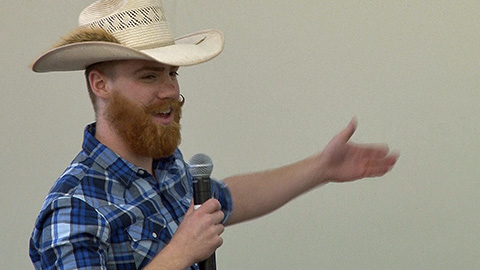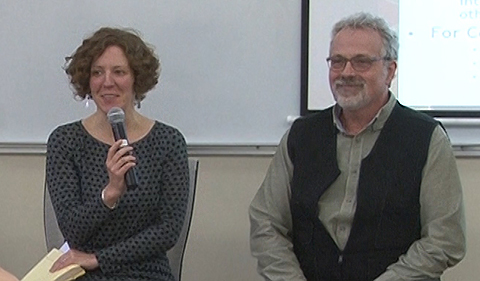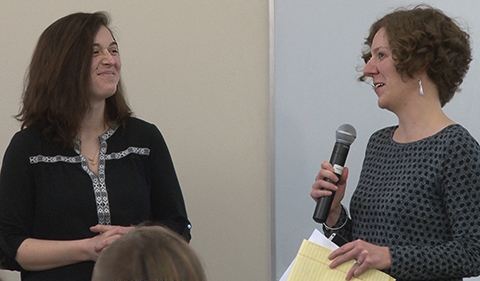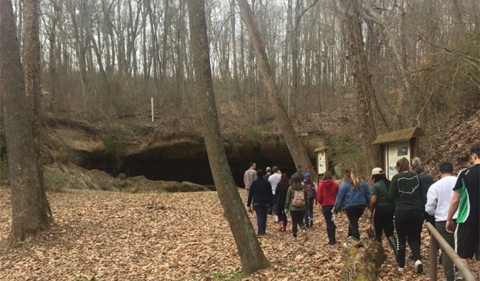Dr. Rachel Terman, John Winnenberg, and Ohio University students Toshia Edge and Wes Gilkey ’18 spoke about service learning, local organizations partnering with the university, and the Little Cities of Black Diamonds micro-region—a series of remnant local mining towns in Southeastern Ohio—as a classroom.
Their presentation was As part of Wealth & Poverty Week on Rural America.

Wes Gilkey
The Little Cities of Black Diamonds Micro-Region
The micro-region referred to as the Little Cities of Black Diamonds is a series of remnant local mining towns surrounded by The Wayne National Forest in Southeastern Ohio, culturally defined by nationally significant events that took place during the Hocking Valley coal boom era (1870-1925), explained Dr. Edna Wangui, Associate Professor of Geography, who welcomed everyone to the talk.
In addition, the environmental landscape of the region is defined by the legacy of unregulated coal mining during the boom era that required nearly a century of recovery and is still taking place to this day.
The region covers the rugged hill country of parts of Perry, Hocking, Athens, and Morgan counties and is defined by the Sunday and Monday Creek Watersheds that feed the Hocking River.
Local Organizations
Community members, faculty, and students have collaborated on various forms of partnership with the Little Cities region.
Winnenberg, a native of the Little Cities micro-region, is Lead Staff Associate at Sunday Creek Associates and provided some context about the region and his work in the area. He described the story of the Little Cities of Black Diamonds as the story of the following:
- Labor unions
- Coal mining
- Race and immigration
- Environmental abuse and recovery
His work has focused on building a positive and alternative identity for the micro-region by promoting the assets of the communities rather than the impoverishment that so many see. These assets include publications and events that celebrate the area’s culture and history, including the Tour de Forest benefit bicycle ride later this month, Appalachian Spring events, and Little Cities of Black Diamonds Day in the Fall.
Winnenberg and local organizations seek to engage the public with guided tours, historic markers, and living history characters, while working to include young people through partnerships with local schools, including Ohio University.
The strong focus on mutually beneficial arrangements includes a strong emphasis on respect for the richness of this history, the wisdom of local people, and the assets of the communities, even while recognizing the poverty that can be an easily visible part of the countryside.
Local organizations seek relationships that are long-lasting to work together on identifying and solving problems, as well as documenting the rich history of the area.

Rachel Terman and John Winnenberg
In the Classroom
Terman, Assistant Professor of Sociology, spoke about how OHIO faculty are engaged in research and community engagement in the area and specifically how she has incorporated Little Cities of Black Diamonds in her classes, especially in her Sociology of Appalachia class.
She gave a brief background on how the beginning of her academic career was grounded in a service-learning project she had in an undergraduate class, followed by an internship at High Rocks for Girls. All this work inspired her interest in young people in Appalachia and incorporating service learning in the courses she teaches now.
OHIO’s Vision statement reflects the value Ohio University places on transformative education.
Terman talked about the importance of having students connect theory to real life experiences in her classes on Wealth & Poverty, including Sociology of Appalachia.
Incorporating service learning like this does take some extra time for an instructor, and Terman highlighted some ways to ease into partnerships that may make it easier for faculty interested in doing so.
Her advice to students is to look for C-designated courses, as well as classes that talk about including a service learning component.
Student Experience
Edge is a University College student pursuing a Wealth & Poverty certificate, and Gilkey is a sociology-criminology and Russian double major, pursing a certificate in Russian Studies.

Toshia Edge and Rachel Terman
They spoke about the value of their involvement in the Temperance & Taverns event during their Fall semester Sociology of Appalachia class. Gilkey spoke about how the class and the service-learning component confirmed his interest in helping people he grew up with, inspiring him to focus on rural development in this community. To him the best parts were the experience of having the freedom to choose his project topic, focusing on the research, and then sharing it with the community, where he got to talk with people about their culture and history, which essentially expanded the scope and depth of his research on moonshine in Southeastern Ohio.
Edge echoed Gilkey’s key points of the benefit of the independent nature of the selection of topic and research, as well as the interaction with community members. She said that while the lack of structure was initially confusing, it was rewarding in the end. Well worth the time and effort!



















Comments